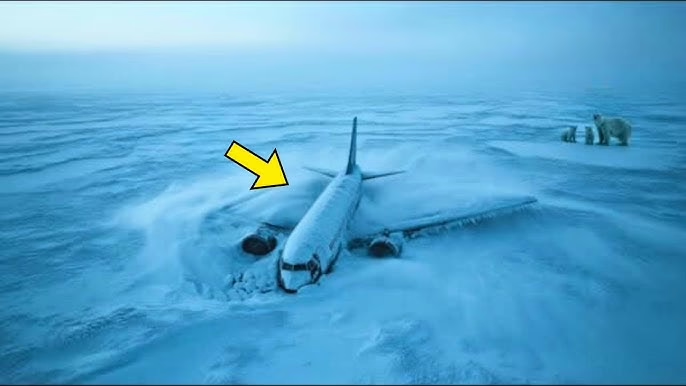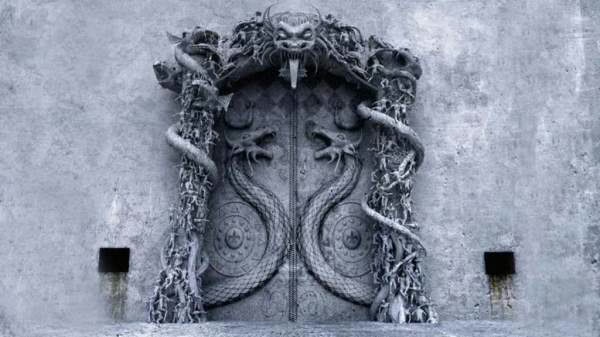It was supposed to be routine — a standard Arctic survey, nothing more than collecting geological data and monitoring glacial drift. We’d done this dozens of times before. But that day, the readings on our instruments told a different story. Something metallic was buried deep beneath the ice — large, structured, and cold in a way that defied explanation.
When we reported the anomaly, the higher-ups ordered us to stand down. “Routine crash,” they said. “Nothing to see here.”
But the data didn’t lie.
And neither did our instincts.
Against protocol, we stayed. We drilled deeper, chasing the truth that the frost had buried for decades.
We didn’t know then that the silence waiting below would haunt us forever.
The Wreck That Shouldn’t Exist
The Arctic wind screamed across the white expanse as our augers cut into the ice. Beneath layers of frozen history, metal began to glint through the frost — a shape emerging where none should be.
At first, we thought it might be a small aircraft, maybe a cargo drop gone wrong. But as the ice cracked and peeled away, the full shape revealed itself — a fuselage, massive and unmistakably ancient.
Sophia gasped. “It’s a plane.”
The aircraft sat half-buried, tilted slightly to one side, its hull frozen in time. Rust had eaten into the metal, yet the structure remained unnervingly intact. The Arctic air stung our faces as we stood before it, four dots against the endless white.
“Brian,” Sophia whispered — my name sounded strange in that silence. “What’s a plane doing all the way out here?”
No one answered. The coordinates didn’t match any known crash site. There were no records, no flight plans, no history that placed an aircraft in this sector of the Arctic.
That alone should have been enough to make us turn back. But curiosity is a dangerous kind of warmth. It keeps you moving when logic tells you to stop.
Breaking the Seal
The snowstorm picked up as Marcus started digging, his shovel ringing against the frozen metal with each strike. “We’re making history here,” he said between breaths, his excitement undimmed by the cold.
Elena stood apart, arms crossed, her face shadowed by concern. “We shouldn’t open this,” she said quietly. “Not without clearance.”
“Orders said to stop,” Sophia reminded me.
I glanced at the reading again. The fuselage emitted faint electromagnetic interference — steady, pulsing, unnatural. “I just want a look inside,” I replied. “We’ll document everything. Then we’ll call it in.”
That was the lie we told ourselves.
The ice gave way under the combined heat of our drills and the relentless bite of our tools. The plane’s hatch groaned, resisted, then creaked open. A gust of air rushed out — frigid, sterile, ancient.
The cold didn’t hit first. The silence did.
It wasn’t empty silence. It was heavy, aware, like the quiet that fills a room after something terrible has happened.
The Tomb of Metal and Frost
Our flashlights cut through the darkness, revealing rows of frost-covered seats. They stood in eerie stillness, untouched by time. Some were broken, others upright — all empty.
Sophia raised her camera, the click of the shutter echoing unnaturally loud. “It feels like we’re trespassing,” she said softly.
The air smelled stale, like a mix of old fuel and decay. Every sound seemed swallowed before it could travel far.
Marcus ran his hand over a seatback. “Still intact,” he murmured. “This shouldn’t be possible. At these temperatures, corrosion—”
“Shh,” Elena hissed. “Do you hear that?”
We paused. The wind outside had died completely. Even the hum of our equipment seemed to fade, replaced by something else — a low hum, faint, like machinery buried deeper still.
Our breath clouded in the narrow beams of our flashlights as we pushed forward.
Near the rear, Sophia found a stack of yellowed papers — flight manifests, obituaries, personal letters. She knelt, brushing the frost away.
“These people had families,” she whispered. “Children. Look — 1962.”
Marcus frowned. “That can’t be right. This model didn’t even exist then.”
I looked around. The markings on the walls were wrong — not standard airline insignia, but a series of geometric etchings, almost runic, carved into the metal itself.
“What is this place?” Elena breathed.
The deeper we went, the less it felt like a crash site and more like a burial.
The Night Watch
By the time we set up camp beside the wreck, the snowstorm had grown vicious. The wind howled like a living thing. Static hissed across our radio — no contact with base, no response.
Marcus huddled near the heater, flipping through his notes. “You realize we’ve stumbled onto something classified, right?”
Elena’s eyes darted toward the wreck. “Or cursed.”
She wasn’t joking. None of us laughed.
The next morning, we found tracks in the snow — not ours. Small, narrow impressions circling the wreck. They led toward the horizon, then vanished.
“Could’ve been wildlife,” Marcus offered weakly.
“In the middle of a storm?” Sophia shot back.
We said nothing more.
By midday, we were back inside the plane. The deeper sections were still frozen shut, but Marcus was determined. He scraped away layers of frost until his gloves tore. That’s when he noticed it — a faint indentation near the cockpit.
Symbols again. Dozens of them.
Circular patterns, repeating. Some glowed faintly under our flashlights, like the ice itself was reacting.
The Compartment
The cockpit was a tomb. The control panels were intact, but frost had crystallized across every surface, catching the light like shattered glass.
Sophia began photographing everything — the seats, the panels, the strange etchings that lined the frame.
“This isn’t just a crash,” she said. “This was intentional.”
Elena knelt near a section of warped metal. “Brian, there’s a panel here that doesn’t fit. See the edges?”
I crouched beside her. She was right — it was newer, smoother. A sealed compartment.
Marcus fetched a crowbar. “Only one way to find out.”
The first attempt failed. The second made the panel shift slightly, releasing a hiss — not air, not gas, but something that made the hair on my arms rise.
“Careful,” Sophia whispered.
Marcus gave one final heave. The panel snapped open with a metallic pop.
Inside was… light.
A dull, pulsating glow that illuminated our faces in the gloom. Something was embedded within — sleek, metallic, impossibly smooth, unlike any known material.
“What the hell is that?” I muttered.
Marcus leaned closer. “It’s warm.”
He was right. Even in subzero cold, it radiated faint heat.
The Artifact
It was no part of the plane. No wiring, no bolts, no rivets. Just a single piece of seamless material — dark silver, humming faintly, pulsing like a heartbeat.
Sophia filmed everything, her voice trembling as she narrated. “Unidentified object discovered inside the fuselage… emitting low-frequency vibrations.”
Elena’s hand hovered inches above it. “It feels alive,” she whispered.
Then the lights in the plane flickered.
The glow from the artifact intensified, illuminating strange engravings along the cockpit walls — patterns that hadn’t been visible before. They pulsed in sync with the object, forming shapes like constellations.
The temperature dropped. Our breath crystallized instantly.
And then — voices.
Whispers, faint but distinct, like radio chatter underwater. Words in no language we recognized.
Sophia stumbled back, camera shaking. “Did you hear that?”
Marcus nodded slowly, his face pale. “I think it’s… speaking.”
The Decision
We backed away. The hum grew louder, deep enough to vibrate through our bones.
“This thing isn’t dead,” I said.
Elena’s voice was steady but cold. “Then we cover it back up.”
Marcus hesitated. “We can’t. This is proof of—”
“Of what?” she snapped. “That we found something we don’t understand? That we woke something that was supposed to stay buried?”
Sophia’s camera clicked once more before she lowered it. “She’s right. This… isn’t meant for us.”
We resealed the compartment, metal groaning as we forced it shut. The hum faded, though the echo lingered in the still air.
When we stepped outside, the snow had stopped. The world was unnervingly still again.
The wreck behind us seemed smaller now, swallowed by the ice and sky.
The Secret We Carried
Back at camp, we said little. The fire crackled, the wind whispered against the tent, and our unspoken pact settled like frost in the air.
“We don’t report this,” I said finally.
Marcus stared into the flames. “You’re serious?”
“Yes. Some truths are too dangerous.”
Sophia nodded. “We’ll document it, hide the evidence. When the world’s ready, maybe then.”
No one argued.
We packed up at dawn. The plane, half-submerged in ice once more, looked peaceful — like it had never been disturbed.
But deep inside, behind that sealed panel, something still pulsed, slow and patient, waiting for the next curious soul to listen.
Epilogue: The Return of the Signal
Weeks later, as we reviewed our footage back at the research station, Sophia froze the playback. “Look at this frame,” she said, zooming in on the last second before the lights flickered.
In the reflection of the cockpit glass, faint but clear, was the outline of a figure — not one of us.
Tall. Motionless. Watching.
We went silent. The equipment beeped softly. The Arctic wind howled against the windows.
And then, from the static of the radio that had been dead since the expedition, a single word broke through the noise:




